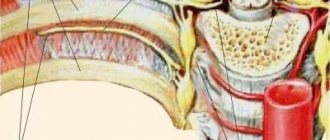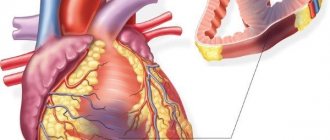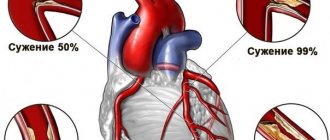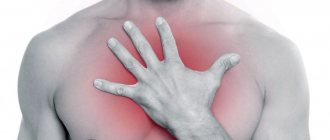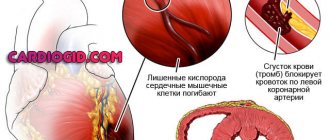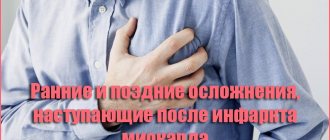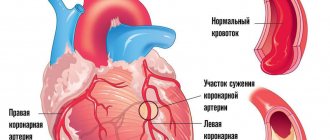A spasm in the chest can plunge you into panic, because everyone knows that heart problems are not something to joke about. But this syndrome is not always a signal of cardiac distress; neuralgia or a host of other reasons may similarly be a concern. And then the drugs used to restore the myocardium and blood vessels will not help. Is it possible, without being a specialist, to understand whether it is pain in the heart or neuralgia, how to distinguish one from the other?
What is the difference?
Pain in the heart area is a group of symptoms that combine discomfort sensations localized in the middle of the chest in the projection area of the corresponding organ. The causes of the clinical picture can be diseases of both the membranes of the heart and the structures located nearby.
For the differential diagnosis of neuralgic and cardiac pain, a comprehensive analysis of the patient’s individual sensations, auxiliary laboratory and instrumental methods are used.
When the nervous system is damaged, the symptoms described are caused by compression of individual fibers at the exit site of the spinal cord. There is no actual damage to the myocardium, but due to the anatomical proximity and the characteristics of the propagation of impulses, a person mistakes the pain for heart pain.
Diseases that cause neuralgia:
- Osteochondrosis.
- Spondylosis.
- Infectious lesions of bone tissue due to tuberculosis or syphilis.
- Vertebral hernias.
- Traumatic injuries.
In controversial situations, it is important to recognize in time what specifically worries the patient. Depending on the preliminary diagnosis, therapy is selected.
Heart pathology is characterized by direct involvement of the membranes of the corresponding organ into the pathological process. The clinical picture differs depending on the disease. In 85% of cases, neuralgia must be quickly differentiated from myocardial infarction or angina pectoris. The reason is the need to choose a treatment method to prevent death or disability of the patient in the future.
According to the recommendations of European, American and Russian cardiologists, the patient has 2 hours to restore the patency of a coronary artery blocked by a thrombus. Therefore, it is necessary to differentiate the cause of discomfort in the chest as quickly as possible.
With myocarditis and pericarditis, the patient will also feel pain in the heart area. A pressing sensation prevails, shortness of breath increases. In addition to chest discomfort, the patient finds it difficult to perform physical exercise. However, in this case, the urgency of hospitalization of a person is not as critical as in case of MI.
Distinctive signs of intercostal neuralgia and heart disease
It is almost impossible to identify the symptoms and treat neuralgia in the heart area without consulting a doctor and examination.
If you look at all the signs in more detail, you can understand in which cases it is necessary to urgently consult a specialist.
Distinctive features of pain due to neuralgia
Neuralgic pain can occur after unusual activity, trauma, shingles, an uncomfortable position during sleep, hypothermia, or a deficiency of B vitamins. It is characterized by the following symptoms:
- pain begins gradually;
- may have a sharp or stabbing onset;
- when an area of skin is irritated or palpated, a sharp pain reaction occurs;
- covers a limited area of the chest;
- spreads along the rib along the path of the nerve.
Distinctive features of pain in heart disease
- begin after physical activity or emotional stress;
- appear gradually and intensify;
- dull, aching or pressing pain;
- cover the middle of the chest and the area behind the sternum;
- attacks are generally controlled by nitroglycerin;
- often spreads up and down from the source;
- shortness of breath, cold sweat, nausea, vomiting, loss of consciousness are observed;
- when irritated by touching the skin and muscles, a painful sensation occurs.
Features of heart pain
An analysis of the accompanying symptoms will help determine whether the heart hurts or whether it is neuralgia. A brief survey of the patient is a simple way to differentiate the disease. Myocardial pathology such as heart attack or angina pectoris is characterized by a clear connection with physical activity and stress. The reason is an increased load on the myocardium, which in conditions of disease (narrowing) of the coronary vessels causes pain. The symptom occurs due to inappropriate oxygenation of muscle tissue. Cells stop “breathing” normally, which leads to gradual death. The result is necrosis (infarction) with increasing pain.
Fear of death is a characteristic symptom that accompanies patients when a heart attack occurs. The lethal outcome in 65-75% of cases is due to the development of fatal arrhythmias (ventricular fibrillation) against the background of a heart attack. When the nervous system is damaged, there is no corresponding sign.
Features of the clinic for ischemia:
- Increasing or occurring at the peak of emotional stress or during physical exercise.
- The nature of the symptom is sharp pressing or burning pain in the area of the heart.
- Irradiation (spread) of discomfort to the left arm, shoulder blade, corresponding side of the neck and jaw.
- Increased heart rate (tachycardia), the occurrence of arrhythmias.
- Reducing the severity of pain due to the use of Nitroglycerin.
Among other causes of heart pain, it is necessary to highlight inflammatory diseases of the membranes (myocarditis, endocarditis, pericarditis). In these situations, fever and a decrease in the pumping function of the myocardium come to the fore. Associated symptoms are a feeling of heaviness in the chest, swelling in the lower extremities, fluctuations in blood pressure.
Heart failure is additionally accompanied by shortness of breath and cough, which is caused by stagnation of blood in the lungs. In the absence of timely treatment, the problem progresses. Pulmonary edema occurs. Pressing pain in the chest is accompanied by difficulty breathing. Pink foam forms around the patient's mouth; the person takes a forced sitting position with emphasis on straightened arms to facilitate inhalation.
How do heart diseases manifest?
Many diseases can be recognized at their very beginning by paying attention to the body's signals for help. Signs of the development of heart disease are common to several other pathologies. The first thing you need to pay attention to is whether the person is at risk. For example, people with elevated cholesterol levels, blood pressure, excess body weight and diabetes should not ignore the following symptoms:
- Discomfort in the chest, which manifests itself in different ways (pressure or feeling of fullness, burning, pinching). The sensations occur both during physical activity and at rest. The discomfort usually goes away after a few minutes.
- Stomach pain, heartburn, nausea, upset. Such symptoms in themselves indicate pathologies of the gastrointestinal tract, but sometimes they signal heart disease in women if there are risk factors.
- Referring pain to the arm. It is felt that the onset of discomfort is localized in the chest area. But sometimes my hand hurts more.
- Dizziness in combination with other signs that indicate malfunction of the heart muscle.
- Sore throat if it spreads to the maxillofacial area from the sternum.
- A sharp feeling of fatigue or shortness of breath with the slightest exertion.
- Heavy snoring indicates breathing problems that affect the heart.
- Cold sweat combined with other symptoms.
- Constant cough.
- Swelling of the lower extremities, which often indicates insufficient heart function.
- Arrhythmia at rest.
A timely response to the presence of a complex of symptoms of heart pathologies can save a person’s life.
Manifestations of neuralgia
Nerve damage is not accompanied by a clear symptom complex that would allow a final diagnosis to be made. Verification of the cause of the problem is carried out by excluding other, more dangerous pathologies.
Neuralgia has no connection with physical activity or stress. Certain sensations arise suddenly or disturb the patient throughout the day. Sharp pain occurs against the background of bending the body, coughing, sneezing. The reason is compression of the nerve fibers. To characterize this symptom in neurology, the term “lumbago” is used.
Methods for determining the nature of pain
The nature of the sensations is the determining factor in understanding what hurts: the heart or the nerve. However, in 90% of situations the patient cannot independently determine the root cause of a particular symptom. Seeing a doctor is a person’s main task.
To verify the nature of the disease causing pain in the heart area and differential diagnosis, the doctor uses auxiliary instrumental methods:
- Electrocardiography (ECG) is a basic study in cardiology. The procedure is based on recording electrical potentials generated by the heart. Using an ECG, organic damage to the myocardium is diagnosed, which makes it possible to distinguish heart pain from neuralgia.
- Coronary angiography is an invasive method for assessing the condition of the vessels that supply blood to the heart. The essence of the study is to visualize the arteries on the screen after the injection of a contrast agent. If there are narrowings in the lumen of the bloodstream, the doctor will be able to see the problem on the monitor. With neuralgia, coronary angiography remains uninformative.
- Chest X-ray or computed tomography of the spine. These techniques are used to assess the intervertebral space. If there are narrowings, compression of the sensory roots is confirmed, which causes pain along the corresponding nerves.
- Echocardiography (EchoCG) is an ultrasound method of examining the heart that visualizes the organ. If there is a pathology that provokes pain, the doctor will register deviations from the norm on the monitor.
If a myocardial infarction is suspected, a laboratory test is additionally performed to determine the level of a specific protein, troponin, in the blood. A positive test result confirms the presence of necrosis of the heart muscle, which is one of the most common causes of severe pressing pain in the chest.
Table of differences
To make it easier to navigate what exactly is bothering a person: neuralgia or the heart, let’s consider the comparative characteristics of these diseases:
| Factors and Features | Intercostal neuralgia | Heart |
| Age group | Regardless of age | People in the older age group (from 40 years of age) are predominantly affected. |
| Localization location | Along the costal arch on one or in rare cases on both sides | Usually on the left side of the chest |
| Where does the pain go? | No irradiation | There is a feeling that the left shoulder and collarbone are bothering |
| Dyspnea | Rarely accompanies | Almost always appears against a background of severe pain |
| Nature of sensations | Aching pain, tingling, less often - lumbago | A feeling of squeezing, which becomes unbearable in case of myocardial infarction, acute pain - in case of angina pectoris |
| Dependence on physical or emotional stress | The connection is not always traceable, only with significant overvoltage | Even moderate exercise often provokes pain. |
| Connection with Breath | Discomfort increases when exhaling or inhaling | Not traceable |
When determining what pathology provokes pain, it is necessary to take into account a complex of symptoms and factors.
First aid
Only a doctor can accurately determine whether the heart hurts or whether intercostal neuralgia is progressing. However, even before the doctor arrives, the patient tries to reduce the severity of the symptom. To minimize discomfort in the chest, medications of two basic groups are used - nitrates and non-steroidal anti-inflammatory drugs.
If relief occurs after using nitroglycerin, then it can be argued that there is heart pain such as angina or heart attack. A decrease in the severity of the symptom while taking paracetamol or ibuprofen indicates the neuralgic nature of the symptom.
In addition to taking specialized medications, the patient is advised to lie down and calm down. Before the doctors arrive, any physical activity is not recommended. Even going up or down stairs can cause aggravation of clinical symptoms.
Treatment
In the fight against left-sided thoracalgia, complex treatment is used, which is aimed at solving the following problems:
- relief of pain;
- relieving inflammation;
- elimination of the disease that caused neuralgia.
To get rid of pain and improve the general condition, methods are prescribed such as: taking medications (analgesics, anti-inflammatory drugs, muscle relaxants, vitamins); physiotherapy (UHF, electrophoresis, laser therapy, acupuncture).
For a patient suffering from intercostal neuralgia, during an exacerbation it is recommended:
- adhere to bed rest, using a flat and hard surface;
- do not drink alcoholic beverages;
- avoid severe stressful situations.
After getting rid of severe pain, it is necessary to establish the cause that provoked the attack of thoracalgia and proceed directly to the treatment of this disease.
If the development of pathology occurs against the background of deformities of the spinal column, then treatment is applied, including:
- exercise therapy;
- special massage;
- physiotherapy;
- manual therapy;
- acupuncture;
- osteopathy.
Learn more about the treatment methods for intercostal neuralgia:
- To find out how dangerous intercostal neuralgia is for pregnant women, follow the link
- How and with what help is intercostal neuralgia treated at home?
- Find out more about the treatment of intercostal neuralgia using ointments and injections on the page
- A list of names of tablets for intercostal neuralgia and their descriptions are here
Drugs
Did you know that...
Next fact
Treatment of intercostal neuralgia on the left side with medical means includes taking medications from the following pharmacological groups::
| Group | Action | Names |
| Analgesics | Relieve pain syndrome |
|
| Nonsteroidal anti-inflammatory drugs | Eliminate inflammation, reduce pain |
|
| Muscle relaxants | Helps relax muscles and relieve spasms |
|
| B vitamins | Regenerate nerve tissue |
|
| Anesthetics | Relieves acute pain |
|
| Sedatives | Fight stress and insomnia |
|
| Diuretics | Relieves puffiness |
|
Surgical method
The use of surgical intervention for left-sided thoracalgia is possible if conservative therapy is ineffective . The surgical method can be aimed at treating osteochondrosis and spinal disc herniation, which caused neuralgia. The operation is indicated for large formations in the area of the spinal column that cause compression of the nerve roots and cause pain.
Exercise therapy and massage
Physical therapy exercises and massage sessions are more effective in treating intercostal neuralgia on the left and help:
speed up blood circulation;- increase the speed of metabolic processes;
- relax muscles and eliminate spasms;
- strengthen the muscle corset;
- reduce pain;
- improve overall well-being;
- prevent re-development of neuralgia.
To enhance the relaxing effect of the massage, it is recommended to use a warming cream . The procedure is carried out in a sitting position and involves rubbing and stroking the intercostal spaces and spinal muscles.
The set of exercises, intensity and duration of training for each patient is selected exclusively by a specialist in this field. When performing special gymnastics, sudden movements of the body and lifting weights should be avoided. Exercise therapy can be done either under the supervision of a professional or independently at home.
Home medicine
In the fight against intercostal neuralgia, along with traditional treatment methods, folk remedies are successfully used to relieve pain and eliminate inflammation.
To make you feel better, use the following recipes::
| Ingredients: | Preparation |
| Flaxseeds | The grains of the plant are wrapped in gauze and steamed, and then applied in the form of applications on the left side |
| Horseradish root | Squeeze the juice from this part of the plant and apply it to the affected area. |
| Wormwood, sea buckthorn oil | Steam the wormwood and combine with oil. Apply the resulting mixture to the left side of the chest. |
| Alcohol, pepper patch | Treat the affected area with alcohol and wipe dry, then apply a patch to the skin. |
| Salt or sand | Apply bags of warm salt or sand to the problem area |
| 4 tbsp sage, 100 g sea salt, 0.25 l boiling water | Brew sage in water, leave for an hour, then strain. Add salt and broth to the bath, lie down for 15-20 minutes |
| 0.1 l milk, 1 tbsp honey, 5 drops eucalyptus and lavender oil | Combine all components and pour into the bath. Immerse yourself in water for 10-15 minutes; there is no need to rinse the skin after the procedure. Repeat sessions 1 time every 2 days |
Prevention
In order to prevent the development of thoracalgia on the left side, as well as to avoid relapses of the disease, you should follow simple recommendations:
- monitor general health;
- sleep at least 8 hours;
- eat well;
- eat foods containing B vitamins;
- exercise daily;
- maintain correct posture;
- avoid excessive loads;
- prevent hypothermia of the body;
- do not abuse alcoholic beverages;
- quit smoking.
